#carcinus
Text

Lernean Crab, the 245th Known One.
#the crab constellation used to be the crayfish?? carcinization even happens in the sky#in my design the lernean hydra is a huge dog with parasitic worms protruding from its behind so the crab is a huge dog lice#also trying to be faithfull to medieval representations i saw on stainglasses#pseudofauna#lernean crab#carcinus#karkinos#zodiac#hydra#hercules#herakles#greek mythology#Europe#lice#crayfish#carcinization#parasite#mythology#chimera#monster#bestiary#creature design#ink#980#octem 123#aer 4#the Known Ones
204 notes
·
View notes
Text
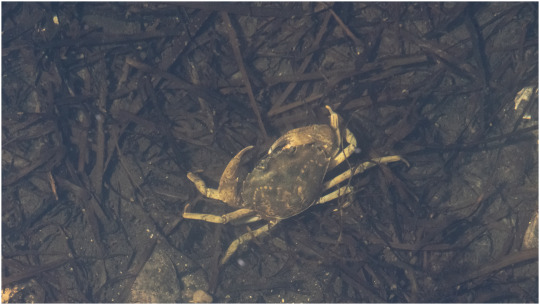
Almindelig strandkrabbe (Carcinus maenas)
Green Shore Crab (Carcinus maenas)
#Almindelig strandkrabbe#Carcinus maenas#Carcinus#Green Shore Crab#Krabbe#Crab#Portunidae#Sommer#Summer#Nibe Havn#Limfjorden
11 notes
·
View notes
Text

drawing Qiuheng is so calming. he gives off that beautiful, tragic gege energy.
12 notes
·
View notes
Text
Fossil Shark Teeth ID Project
I am currently working on a shark teeth ID project. It is a personal project I am working on because I got gifted a multitude of fossil shark teeth of various species.
I am fairly sure that the teeth (seen in the two pictures below) belong to the family Lamnidae and are from the species Cosmopolitodus hastalis.
If these teeth are in fact the teeth of Cosmopolitodus hastalis they ought to date back to the Miocene and Pliocene (which are the two epochs of the Neogene). Although the species was still alive during the Pleistocene, fossils found of Cosmopolitodus hastalis in Cadzand (in the Netherlands) date back to the Miocene and Pliocene.


One of the shark teeth (the left picture below) gifted to me is so severely eroded that I cannot visually identify it, however it is still a gorgeous fossil.
Between the various shark teeth I also found what I suspect to be a part of a fossilised chela (claw/pincer of a crab) (seen in the right picture below). Considering the location of the find I think it might be from Carcinus maenas and could date back to the Pliocene.


#hyperfixation#marine biology#paleontology#selachimorphology#shark biology#sharkblr#shark tumblr#fossil shark teeth#shark teeth#shark teeth ID#Lamnidae#Cosmpopolitodus hastalis#decapoda#crab#Carcinus maenas#fossils#⊹ ࣪ ﹏𓊝﹏𓂁﹏⊹ ࣪ ˖
6 notes
·
View notes
Text
Shrimp of the Day #46
Macrobrachium carcinus
also known as the Painted River Prawn, and the Bigclaw River Shrimp.


#shrimp#shrimpblr#shrimp of the day#sotd#freshwater shrimp#caridea#these are some of the biggest freshwater shrimp#the US forest service says they can reach 18 inches and one pound#which is insane#Macrobrachium carcinus#painted river prawn#bigclaw river shrimp
6 notes
·
View notes
Text
Nova Verba Latina / New Latin Words
carcinus -i m. “carcinus”
[καρκίνος “crab”]
[καρκινο-] stem
[carcin-] καρκινο- Latinized
[carcinus] nominative singular

(Fons Imaginis.)
#Homo carcinus#Carcinization#latin#latin language#latin translation#lingua latina#tagamemnon#latin fandom#latin meme#latin memes#meme#memes#Word Formation#Latin Word Formation
2 notes
·
View notes
Text
getting emotional about things that are still like 60 chapters away from happening in I Know The End but I wrote them in August 2022

#ismene prior my beloved……pescennia jasper…. Amphie and Junior……..#can’t wait for it to be Fuck Carcinus Clay Hours 2 years from now#how fucking funny would it be if I like posted a chapter from the Oscars and ended up winning#ikte#thg
4 notes
·
View notes
Text
Strandkrabben-Bisque
In der zweiten Julihälfte verbrachte ich Teile meines Sommerurlaubs auf der schönen niederländischen Insel Texel. Einer der Höhepunkte war übrigens das Treffen mit dem charmanten Krautjunker Goswin am Paal 17.
Goswin kommentierte dieses Foto später damit, dass er darauf aussieht wie Bilbo, der gerade von Gandalf zu einem neuen Abenteuer überredet wird…
In der Hafenstadt Oudeschild amüsierte ich…
#Anders Schønnemann#Carcinus maenas#Gone Fishing: Fisch und Meeresfrüchte#Mikkel Karstad#Prestel Verlag#Rezept Strandkrabben#Strandkrabben#Strandkrabben Rezept#Strandkrabben-Bisque
1 note
·
View note
Text
Things I saw on my dive today
Anemone (no clue about the species, was brown)
Crabs, (Cancer pagurus and Carcinus maenas probably?? A few were swimming (small and orange), one was blue/black with red eyes)
Various brown/red small fish (I know basically nothing about fish so fuck knows lmao)
Sea squirts (on seaweed, clear with bluey tint)
Peacock worm (Sabella pavonina I'm pretty sure)
Sea star (Asterias rubens for sure, and larger bluey ones)
Urchins (Echinus esculentus ?)
Pipe fish (??? No idea lmao)
67 notes
·
View notes
Text

Giovanni Congia
granchio comune (Carcinus aestuarii D
62 notes
·
View notes
Text
Mermaid Theme
[mermaid theme]
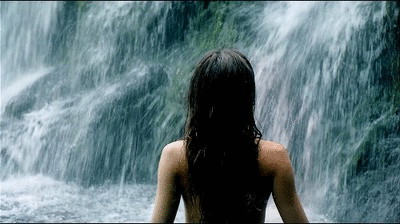

includes sirens, selkies and other fishfolk as well as general water dieties.
if you see duplicates let me know

(Nick)Names:
loralei/lorelei/loralei/loelai/lorelay/loralay/loreley/loraley/lorelie/loralie, lake, loch, limniad, lara, leucothea, lamia, leucosia, ligia, ligeia, laume, llyr, lir, limnade, leiminide
sire, siren/syren, shiren/shyren, sel, selk, selki/selkie/selky, sea, seara, searsia, sirena/syrena, sjokona/siokona, sireno, styx, stheno, scylla, segeta, sequana, souconna, sirona, sinnan, saga, sjora, shoopiltee
mer, merma, marmay/mermei/mermai/mermey, mermaid/mermaide/mermade, mermi/mermie/mermy, mermist, mermista, merman, mermen, mermaiden, mermix, melusine, melyzin, melusna, mel, merwif, meremenn, meer, merrow, marina, meermin/meerminne, min, meri. minne, merimin, meremin. maree, medusa, melusina, morgan/morgen, marimorgen, moryana, moryanki, moriany
ocea, ocean/oceane, oceana, oceania, oceanix, oceanic, oceanice/oceanis, oceanus, oceanid, oceanide, ondine
ran, rain/raine/rayn/rayne, river, revine/ravine, rainy/rainie/raini, rusalka, rhine, rura, rusalki
pearl/perle, pearla/perla, pearly, poseidon, pisces, proteus, palaemon, phorcys, pontus, potamoi, psamathe, parthenope, pisinoe, peisinoe, pegaeae
nymph, nymphie, nympha, naiad, neried, neriede, nereid, nereida, nereide, nix, nixie, neptune, nessie, nereus, nerites, nantosuelta, nodens, nehalennia, nerthus, njoror, nuggle, njogel
kelpie, kymopoleia
water, wodnik
undine/undyne, uiara
haffru, hiara, hippocampi, hippocampus, hi, hip/hipp, hippo, hippoca, hafgufa, hydra
thala, thalasso, thalassa, thalia, tethys, thaumas, thetis, triton, triteia, tritone, thelxinoe, thames, telchine, tangie
ceasg, calypso, ceto, coralia, carcinus, cancer, cymopoleia, coventina, condatis, charibdis, crinaeae, camenae
atargatis, amphitrite, achelous, aegaeon, alpheus, anapos, asopus, asterion, aino, asrai, aglaope, aglaopheme, aglaophonos, acionna, aegir, aspidochelone, ahti, Aughisky, adara, adaro
derketo, doris, dynamene, damona, danu, dana, duberdicus, durius, davy
yara
galene, glaucus, gorgon, graeae, glashtin
brizo, belisama, brigid, boann, bandua, berehynia
eidothea, electra, enipeus, eurybia, euryale
jones
ichthyocentaur
vedenemo, vallemo, vodyanoy, vodník, vodnik, vodenjak, vodyanitsa
1stp prns:
i/me/my/mine
mi/me/mers/mermine
si/sire/sirens/sirine
si/se/selkies/selkine
sci/sce/scy/scaline
fi/fe/fish/fine(fishine)
ti/taile/tailes/tailine
ny/nymphe/nymphs/nymphine
nai/naie/nais/naiadine(naine)
wai/wate/waters/watine
2ndp prns:
you/your/yours/yourself
mo/mer/mers/merself
so/sir/sirens(sirs)/sirself(sirenself)
so/selker/selkirs/selkirself
sco/scaler/scalers/scaleself(scalerself)
fo/fisher/fishers/fisherself
to/tailer/tailers/tailerself(tailself)
no/nympher/nymphrs/nymphself
no/nair/naiars/naiadself
wo/water/waters/waterself
3rdp prns:
they/them/theirs/themselves
mer/maid, mer/folk, mer/man, mer/mers, mer/mermaid, mer/merfolk, mer/merman, mermaid/mermaids, merfolk/merfolks, merman/mermans
si/ren, siren/sirens, si/siren, sel/kie, sel/selkie, selkie/selkies, sca/ale, scale/scales, sca/le, sca/scale
fi/sh, fi/fish, fish/fishy, fish/fishes
ny/nymph, ny/mph, nymph/nymphs, nai/ad, nai/naiad, naiad/naiads
wa/ter, wat/er, wat/water, water/waters, water/nymph
Titles
the mermaid, the merman, the oceanic, the sea/ocean dweller, the swimmer, the devine river, the fish folk, the one of fish-like descent, the descendant of oceanus, the descendant of poseidon/neptune, the nymph, the naiad, the water nymph, the god/goddess of merfolk, the deity of the sea/ocean, the dweller of the deep
*one who dwells in the dark waters, one who has scales, one who lives in a tail and gills, one who breaths with gills, one who rules the deep, one who lives among the creatures of the deep, one who is half fish, one who controls the waves, one who's voice enchants, one who sings of the hearts desires
(*) you can replace "one" with any pronouns
#name list#name blog#names#list of names#title list#names list#list of titles#pronouns#mermay#mermaid#mermaid theme#mermaid names#mermaid pronouns#mermaid neos#mermaid npts#mermaid titles#siren theme#siren names#siren titles#siren pronouns#siren neos#siren npts#npt blog#npt#npd names#npt list#npt ideas#npt suggestions#npt pack#pronoun suggestions
25 notes
·
View notes
Text

The Seashore. Written by Jennifer Cochran. Illustrated by Kenneth Lilly, Patricia Mynott, James Nicholls, and George Thompson . 1973.
Internet Archive
A.) Calanus finmarchicus
B.) Larva of the shrimp Crangon crangon
C.) Larva of the barnacle Semibalanus balanoides
D. + E.) Different stages of the growth of Carcinus maenas
F.) One of the stages of Pisidia longicornis
G.) Eurydice pulchra
H.) Larva of Clytia Johnstoni
#marine life#crustaceans#copepods#shrimp#barnacles#acorn barnacles#crabs#european green crabs#long-clawed porcelain crabs#isopods#speckled sea lice#cnidarians
357 notes
·
View notes
Text

This is incredibly cool! It's a preprint so it's still undergoing peer review, but an enormous study on the terrestrialization of crabs over several stages and phylogenetic groups was just finished and there are some super illuminating findings for how crabs have evolved over hundreds of millions of years. Some of the most interesting implications are those of how invasives, like (my eternally beloathed) Hemigrapsus sanguinus and Carcinus maenas, often have the kind of traits for high habitat adaptability/tolerance that many of these common ancestors for terrestrial crab groups may have shared.
FULL TEXT check it out, it's a really awesome read!
320 notes
·
View notes
Text

After saving some of his scholarship money, Zhihao gives Qiuheng his first binder.
Something from the Carcinus No Aliens AU
#artists on tumblr#comics#webcomics#original characters#ocs#my art#theburningkingart#Original: Carcinus#sweet crab bros#the no aliens AU#brocon
11 notes
·
View notes
Text
Today was the day i finally started researching for science... i think.
I had to identify each species that my advisor managed to find on a beach.
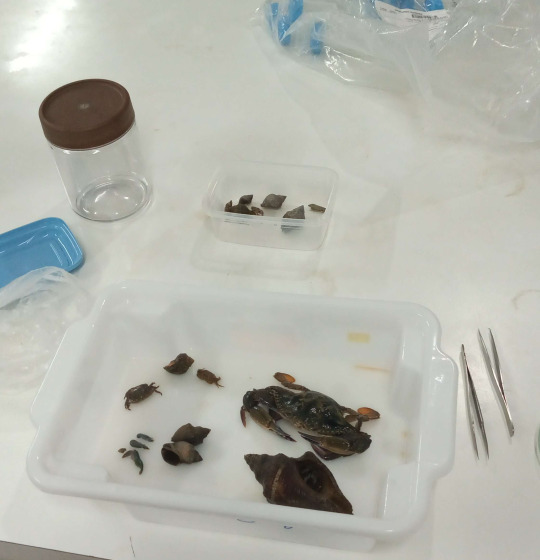
They were collected in a beach which had rocks, on low tide, so some of the species collected were actually common from reefs.
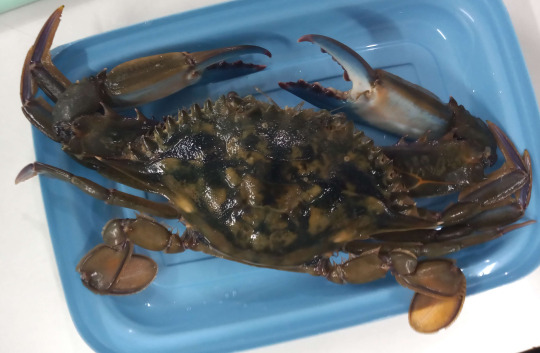
I went from the crabs first, because I thought they were the easiest ones to identify... boy i was wrong, just the brachyura identification of the coast of brazil had basically 800 pages, but this big one here was actually easier to id, because, for one, because of the slippers on their backs, they are surely what the brazilians call a "siri", so from the family Portunidae, to get the actual genre and species was a little bit tricky, basically, the males from the genre Callinectes have their telson in a T form (the book is very vague about what the hell is a T, but its their telson), you had to see little spikes they have around the eyes to determine the species, its probably a Callinectes danae
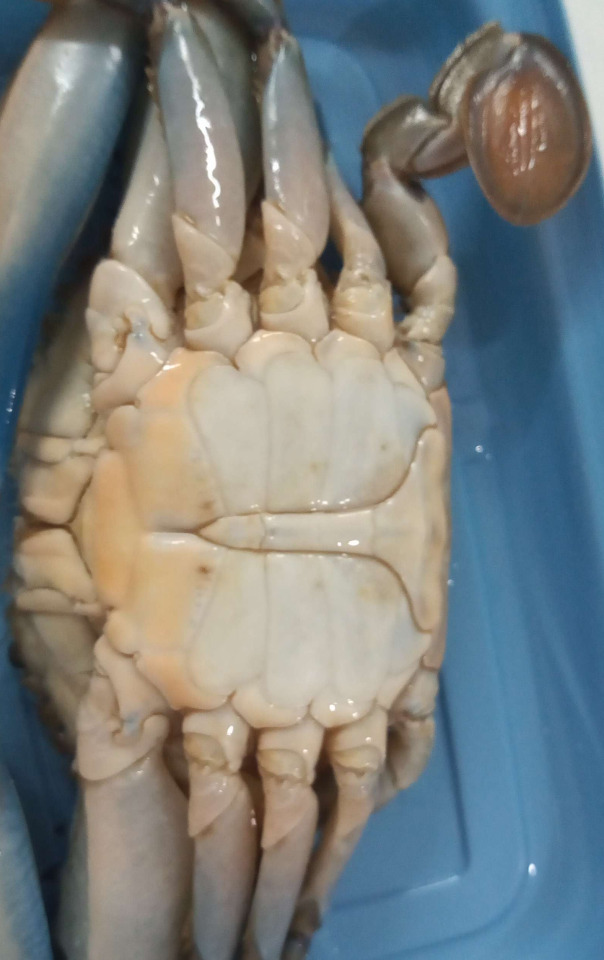
its not their penice s btw,,,
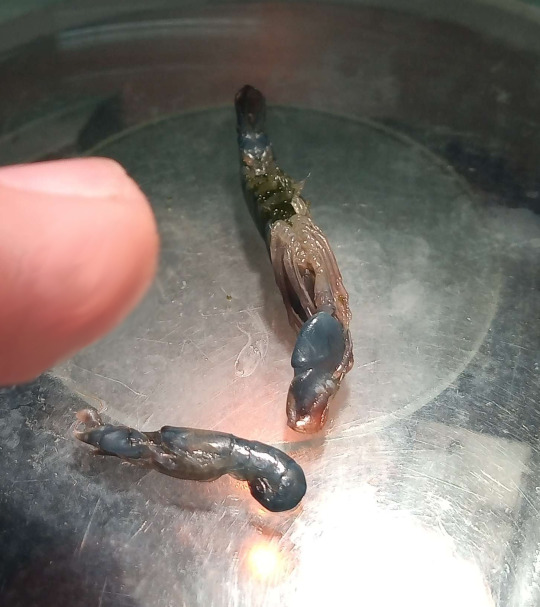
these are pistol shrimps, one of them had eggs with them, i'll have to study some Alpheidae (pistol shrimp superfamily) identifications so i can ID these ones.
The other ones were 2 Carcinus maenas and a bunch of Clibanarius crabs, that i won't show cuz they're pretty gory, because they were stuck in their shells and i had nothing to break the shells, so i had to yank them out (worst part of doing ids with crustaceans).
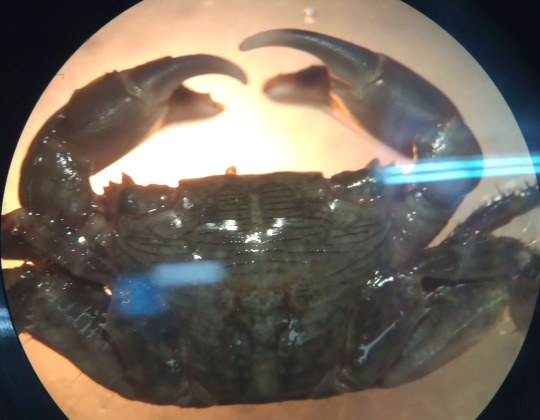
also was a pain in the ass to look cleary throught the lenses of the macroscope, so i made a sketch based on what happened
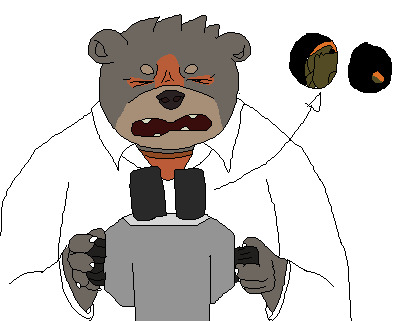
thats it....
7 notes
·
View notes
Text










18.07.24 - Young Darwin Scholarship Day 4
The bulk of today was devoted to rocky shores. We went to East Prawle where we were going to lay quadrats and collect data on the species present at the various coastal zones but as the data software wasn’t working we just explored. I couldn’t take in much information because my pain has been getting worse, I’ve been getting more and more tired and it’s been harder to think clearly, so this post will mainly just be brief descriptions of some of the things I saw and photographed.
1-2. A male European Green Crab (Carcinus maenas)
3. A lot of different seaweeds. Important information is that they are not plants and some of them, such as red seaweed, parasitise each other which is interesting. I can’t remember which species it is but one of them has bulges that look like air sacks but are in fact filled with reproductive material (I guess semen would be the closest analogue). Others do have air sacks.
4. Some sponges of which I don’t know the species - genetically and evolutionarily the closest relative of humans that can be found in a rock pool.
5. Beaded Anemone (Actinia equina)
6. Snakelocks Anemone (Anemonia viridis)
7. The ornate underside of a Cushion Star (Culcita novaeguineae)
8. Rockpool Shrimp (Palaemon elegans)
9. A Grey Seal (Halichoerus grypus) observed from a distance (getting too close stresses seals significantly). This was an interesting find. We didn’t see seals when we were purposely seeking them out on yesterday’s boat trip but we saw one today and the Grey Seal, with it’s characteristic long snout, is more rare on our coastlines than the Common Seal.
10. An out-of-focus Glow-Worm (Lampyris noctiluca), curiously not a worm but a beetle. There were several in the verges between the beach and field centre after we returned from our final evening campfire. We also detected bats on our bat detectors and saw them flying around, possibly Daubenton’s (Myotis daubentonii) as a population nests by the bridge. We also took one last chance to try and spot otters. At one point in the gloom I saw some large ripples and what appeared to be a dark shape but I don’t know if my eyes were playing tricks on me.
#personal#photos#natural history#scholarship#wildlife conservation#not so daily positives#naturalists
4 notes
·
View notes